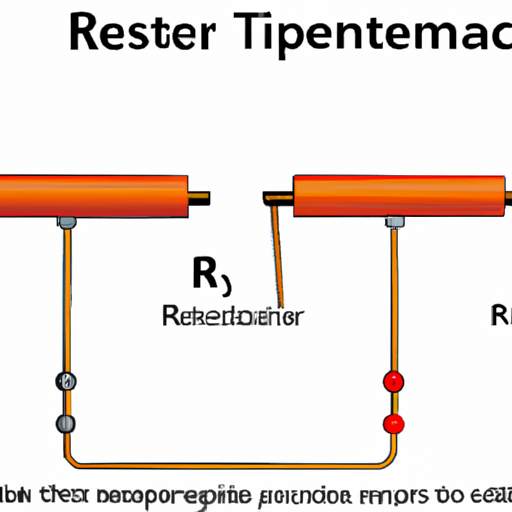What are the Main Parameters of the Resistor?

I. Introduction
A. Definition of a Resistor
A resistor is a fundamental electronic component that limits the flow of electric current in a circuit. It is designed to provide a specific amount of resistance, measured in ohms (Ω), which is crucial for controlling voltage and current levels in various applications. Resistors are ubiquitous in electronic devices, from simple circuits to complex systems, playing a vital role in ensuring proper functionality.
B. Importance of Resistors in Electrical Circuits
Resistors are essential for managing current flow, dividing voltages, and protecting sensitive components from excessive current. They are used in a variety of applications, including signal processing, power management, and biasing transistors. Understanding the parameters of resistors is crucial for engineers and hobbyists alike, as it directly impacts circuit performance and reliability.
C. Overview of the Main Parameters
This blog post will explore the main parameters of resistors, including basic parameters like resistance, tolerance, and power rating, as well as advanced parameters such as temperature coefficient, voltage coefficient, and noise. Additionally, we will discuss different types of resistors and practical considerations for selecting the right resistor for specific applications.
II. Basic Parameters of Resistors
A. Resistance
1. Definition and Units (Ohms)
Resistance is the primary parameter of a resistor, defined as the opposition to the flow of electric current. It is measured in ohms (Ω), named after the German physicist Georg Simon Ohm. The resistance value determines how much current will flow through the resistor when a voltage is applied across it.
2. Ohm's Law and its Relevance
Ohm's Law is a fundamental principle in electronics that relates voltage (V), current (I), and resistance (R) in a circuit. It is expressed as:
\[ V = I \times R \]
This equation illustrates that for a given voltage, the current flowing through a resistor is inversely proportional to its resistance. Understanding Ohm's Law is essential for designing circuits and selecting appropriate resistor values.
B. Tolerance
1. Definition and Importance
Tolerance refers to the allowable deviation from the specified resistance value. It is expressed as a percentage and indicates how much the actual resistance can vary from the nominal value. For example, a resistor with a nominal value of 100 Ω and a tolerance of ±5% can have an actual resistance between 95 Ω and 105 Ω.
2. Common Tolerance Values
Common tolerance values for resistors include ±1%, ±5%, and ±10%. Precision resistors, used in applications requiring high accuracy, may have tolerances as low as ±0.1%. Understanding tolerance is crucial for ensuring that circuits operate within desired parameters, especially in sensitive applications.
C. Power Rating
1. Definition and Units (Watts)
The power rating of a resistor indicates the maximum amount of power it can dissipate without being damaged. It is measured in watts (W). Exceeding the power rating can lead to overheating and failure of the resistor.
2. Importance of Power Rating in Circuit Design
When designing circuits, it is essential to select resistors with appropriate power ratings based on the expected current and voltage levels. The power dissipated by a resistor can be calculated using the formula:
\[ P = I^2 \times R \]
or
\[ P = \frac{V^2}{R} \]
Choosing resistors with adequate power ratings ensures reliability and longevity in circuit performance.
III. Advanced Parameters of Resistors
A. Temperature Coefficient
1. Definition and Measurement
The temperature coefficient of resistance (TCR) quantifies how much a resistor's resistance changes with temperature. It is typically expressed in parts per million per degree Celsius (ppm/°C). A positive TCR indicates that resistance increases with temperature, while a negative TCR indicates a decrease.
2. Impact on Performance
Temperature variations can significantly affect circuit performance, especially in precision applications. Understanding the TCR of resistors helps engineers predict how resistance will change in different environmental conditions, ensuring stable circuit operation.
B. Voltage Coefficient
1. Definition and Relevance
The voltage coefficient of resistance describes how a resistor's resistance changes with applied voltage. This parameter is particularly important in high-voltage applications, where excessive voltage can lead to changes in resistance and affect circuit behavior.
2. Effects on Circuit Behavior
A resistor with a high voltage coefficient may exhibit non-linear behavior under varying voltage conditions, leading to inaccuracies in circuit performance. Selecting resistors with low voltage coefficients is crucial for maintaining signal integrity in sensitive applications.
C. Noise
1. Definition and Types of Noise
Noise in resistors refers to the unwanted electrical signals that can interfere with circuit performance. There are several types of noise, including thermal noise (Johnson-Nyquist noise), shot noise, and flicker noise. Thermal noise is the most common and is generated by the random motion of charge carriers within the resistor.
2. Impact on Signal Integrity
Noise can degrade the quality of signals in electronic circuits, leading to errors and reduced performance. Understanding the noise characteristics of resistors is essential for designing circuits that require high signal integrity, such as audio and communication systems.
IV. Types of Resistors and Their Parameters
A. Fixed Resistors
1. Carbon Composition Resistors
Carbon composition resistors are made from a mixture of carbon and a binding material. They are known for their low cost and ability to withstand high energy pulses, but they have higher noise levels and lower precision compared to other types.
2. Metal Film Resistors
Metal film resistors offer better stability and lower noise levels than carbon composition resistors. They are made by depositing a thin layer of metal onto a ceramic substrate, providing high precision and low temperature coefficients.
3. Wirewound Resistors
Wirewound resistors are constructed by winding a metal wire around a ceramic or fiberglass core. They can handle high power ratings and are often used in applications requiring high precision and stability.
B. Variable Resistors
1. Potentiometers
Potentiometers are adjustable resistors that allow users to vary resistance manually. They are commonly used in volume controls and other applications where variable resistance is needed.
2. Rheostats
Rheostats are a type of variable resistor designed to handle higher currents. They are often used in applications such as dimmer switches and motor speed controls.
C. Specialty Resistors
1. Thermistors
Thermistors are temperature-sensitive resistors that exhibit a significant change in resistance with temperature variations. They are commonly used in temperature sensing and control applications.
2. Photoresistors
Photoresistors, or light-dependent resistors (LDRs), change resistance based on light intensity. They are used in applications such as automatic lighting systems and light meters.
V. Practical Considerations in Resistor Selection
A. Application Requirements
1. Circuit Type and Function
When selecting resistors, it is essential to consider the specific requirements of the circuit, including the type of signal (analog or digital), frequency, and overall function. Different applications may require different resistor types and parameters.
2. Environmental Conditions
Environmental factors such as temperature, humidity, and exposure to chemicals can affect resistor performance. Selecting resistors that can withstand the specific conditions of the application is crucial for ensuring reliability.
B. Sourcing and Availability
1. Common Manufacturers
There are numerous manufacturers of resistors, each offering a range of products with varying specifications. Some well-known manufacturers include Vishay, Yageo, and Panasonic. Researching reputable manufacturers can help ensure quality and reliability.
2. Cost Considerations
Cost is an important factor in resistor selection, especially for large-scale production. While it may be tempting to choose the cheapest option, it is essential to balance cost with performance and reliability to avoid potential issues in the long run.
VI. Conclusion
A. Summary of Key Parameters
Understanding the main parameters of resistors—resistance, tolerance, power rating, temperature coefficient, voltage coefficient, and noise—is essential for effective circuit design. Each parameter plays a critical role in determining how a resistor will perform in a given application.
B. Importance of Understanding Resistor Parameters for Circuit Design
A thorough understanding of resistor parameters allows engineers and designers to make informed decisions when selecting components, ensuring optimal performance and reliability in electronic circuits.
C. Future Trends in Resistor Technology
As technology advances, new materials and manufacturing techniques are being developed to improve resistor performance. Trends such as miniaturization, increased precision, and enhanced thermal stability are shaping the future of resistor technology, making it an exciting area for innovation.
VII. References
A. Books and Articles on Resistor Technology
1. "The Art of Electronics" by Paul Horowitz and Winfield Hill
2. "Electronic Components: A Complete Reference for Project Builders" by Mark J. Balch
B. Online Resources and Databases
1. Digi-Key Electronics
2. Mouser Electronics
C. Manufacturer Specifications and Datasheets
1. Vishay Resistor Datasheets
2. Yageo Resistor Specifications
---
This blog post provides a comprehensive overview of the main parameters of resistors, covering both basic and advanced aspects, as well as practical considerations for selection and application. Understanding these parameters is crucial for anyone involved in circuit design and electronics.
What are the Main Parameters of the Resistor?

I. Introduction
A. Definition of a Resistor
A resistor is a fundamental electronic component that limits the flow of electric current in a circuit. It is designed to provide a specific amount of resistance, measured in ohms (Ω), which is crucial for controlling voltage and current levels in various applications. Resistors are ubiquitous in electronic devices, from simple circuits to complex systems, playing a vital role in ensuring proper functionality.
B. Importance of Resistors in Electrical Circuits
Resistors are essential for managing current flow, dividing voltages, and protecting sensitive components from excessive current. They are used in a variety of applications, including signal processing, power management, and biasing transistors. Understanding the parameters of resistors is crucial for engineers and hobbyists alike, as it directly impacts circuit performance and reliability.
C. Overview of the Main Parameters
This blog post will explore the main parameters of resistors, including basic parameters like resistance, tolerance, and power rating, as well as advanced parameters such as temperature coefficient, voltage coefficient, and noise. Additionally, we will discuss different types of resistors and practical considerations for selecting the right resistor for specific applications.
II. Basic Parameters of Resistors
A. Resistance
1. Definition and Units (Ohms)
Resistance is the primary parameter of a resistor, defined as the opposition to the flow of electric current. It is measured in ohms (Ω), named after the German physicist Georg Simon Ohm. The resistance value determines how much current will flow through the resistor when a voltage is applied across it.
2. Ohm's Law and its Relevance
Ohm's Law is a fundamental principle in electronics that relates voltage (V), current (I), and resistance (R) in a circuit. It is expressed as:
\[ V = I \times R \]
This equation illustrates that for a given voltage, the current flowing through a resistor is inversely proportional to its resistance. Understanding Ohm's Law is essential for designing circuits and selecting appropriate resistor values.
B. Tolerance
1. Definition and Importance
Tolerance refers to the allowable deviation from the specified resistance value. It is expressed as a percentage and indicates how much the actual resistance can vary from the nominal value. For example, a resistor with a nominal value of 100 Ω and a tolerance of ±5% can have an actual resistance between 95 Ω and 105 Ω.
2. Common Tolerance Values
Common tolerance values for resistors include ±1%, ±5%, and ±10%. Precision resistors, used in applications requiring high accuracy, may have tolerances as low as ±0.1%. Understanding tolerance is crucial for ensuring that circuits operate within desired parameters, especially in sensitive applications.
C. Power Rating
1. Definition and Units (Watts)
The power rating of a resistor indicates the maximum amount of power it can dissipate without being damaged. It is measured in watts (W). Exceeding the power rating can lead to overheating and failure of the resistor.
2. Importance of Power Rating in Circuit Design
When designing circuits, it is essential to select resistors with appropriate power ratings based on the expected current and voltage levels. The power dissipated by a resistor can be calculated using the formula:
\[ P = I^2 \times R \]
or
\[ P = \frac{V^2}{R} \]
Choosing resistors with adequate power ratings ensures reliability and longevity in circuit performance.
III. Advanced Parameters of Resistors
A. Temperature Coefficient
1. Definition and Measurement
The temperature coefficient of resistance (TCR) quantifies how much a resistor's resistance changes with temperature. It is typically expressed in parts per million per degree Celsius (ppm/°C). A positive TCR indicates that resistance increases with temperature, while a negative TCR indicates a decrease.
2. Impact on Performance
Temperature variations can significantly affect circuit performance, especially in precision applications. Understanding the TCR of resistors helps engineers predict how resistance will change in different environmental conditions, ensuring stable circuit operation.
B. Voltage Coefficient
1. Definition and Relevance
The voltage coefficient of resistance describes how a resistor's resistance changes with applied voltage. This parameter is particularly important in high-voltage applications, where excessive voltage can lead to changes in resistance and affect circuit behavior.
2. Effects on Circuit Behavior
A resistor with a high voltage coefficient may exhibit non-linear behavior under varying voltage conditions, leading to inaccuracies in circuit performance. Selecting resistors with low voltage coefficients is crucial for maintaining signal integrity in sensitive applications.
C. Noise
1. Definition and Types of Noise
Noise in resistors refers to the unwanted electrical signals that can interfere with circuit performance. There are several types of noise, including thermal noise (Johnson-Nyquist noise), shot noise, and flicker noise. Thermal noise is the most common and is generated by the random motion of charge carriers within the resistor.
2. Impact on Signal Integrity
Noise can degrade the quality of signals in electronic circuits, leading to errors and reduced performance. Understanding the noise characteristics of resistors is essential for designing circuits that require high signal integrity, such as audio and communication systems.
IV. Types of Resistors and Their Parameters
A. Fixed Resistors
1. Carbon Composition Resistors
Carbon composition resistors are made from a mixture of carbon and a binding material. They are known for their low cost and ability to withstand high energy pulses, but they have higher noise levels and lower precision compared to other types.
2. Metal Film Resistors
Metal film resistors offer better stability and lower noise levels than carbon composition resistors. They are made by depositing a thin layer of metal onto a ceramic substrate, providing high precision and low temperature coefficients.
3. Wirewound Resistors
Wirewound resistors are constructed by winding a metal wire around a ceramic or fiberglass core. They can handle high power ratings and are often used in applications requiring high precision and stability.
B. Variable Resistors
1. Potentiometers
Potentiometers are adjustable resistors that allow users to vary resistance manually. They are commonly used in volume controls and other applications where variable resistance is needed.
2. Rheostats
Rheostats are a type of variable resistor designed to handle higher currents. They are often used in applications such as dimmer switches and motor speed controls.
C. Specialty Resistors
1. Thermistors
Thermistors are temperature-sensitive resistors that exhibit a significant change in resistance with temperature variations. They are commonly used in temperature sensing and control applications.
2. Photoresistors
Photoresistors, or light-dependent resistors (LDRs), change resistance based on light intensity. They are used in applications such as automatic lighting systems and light meters.
V. Practical Considerations in Resistor Selection
A. Application Requirements
1. Circuit Type and Function
When selecting resistors, it is essential to consider the specific requirements of the circuit, including the type of signal (analog or digital), frequency, and overall function. Different applications may require different resistor types and parameters.
2. Environmental Conditions
Environmental factors such as temperature, humidity, and exposure to chemicals can affect resistor performance. Selecting resistors that can withstand the specific conditions of the application is crucial for ensuring reliability.
B. Sourcing and Availability
1. Common Manufacturers
There are numerous manufacturers of resistors, each offering a range of products with varying specifications. Some well-known manufacturers include Vishay, Yageo, and Panasonic. Researching reputable manufacturers can help ensure quality and reliability.
2. Cost Considerations
Cost is an important factor in resistor selection, especially for large-scale production. While it may be tempting to choose the cheapest option, it is essential to balance cost with performance and reliability to avoid potential issues in the long run.
VI. Conclusion
A. Summary of Key Parameters
Understanding the main parameters of resistors—resistance, tolerance, power rating, temperature coefficient, voltage coefficient, and noise—is essential for effective circuit design. Each parameter plays a critical role in determining how a resistor will perform in a given application.
B. Importance of Understanding Resistor Parameters for Circuit Design
A thorough understanding of resistor parameters allows engineers and designers to make informed decisions when selecting components, ensuring optimal performance and reliability in electronic circuits.
C. Future Trends in Resistor Technology
As technology advances, new materials and manufacturing techniques are being developed to improve resistor performance. Trends such as miniaturization, increased precision, and enhanced thermal stability are shaping the future of resistor technology, making it an exciting area for innovation.
VII. References
A. Books and Articles on Resistor Technology
1. "The Art of Electronics" by Paul Horowitz and Winfield Hill
2. "Electronic Components: A Complete Reference for Project Builders" by Mark J. Balch
B. Online Resources and Databases
1. Digi-Key Electronics
2. Mouser Electronics
C. Manufacturer Specifications and Datasheets
1. Vishay Resistor Datasheets
2. Yageo Resistor Specifications
---
This blog post provides a comprehensive overview of the main parameters of resistors, covering both basic and advanced aspects, as well as practical considerations for selection and application. Understanding these parameters is crucial for anyone involved in circuit design and electronics.













